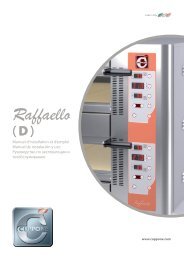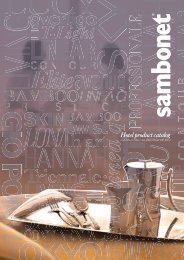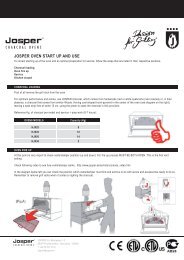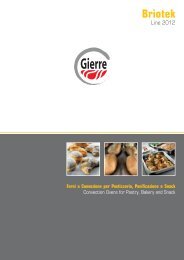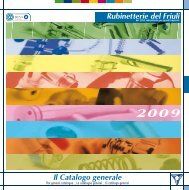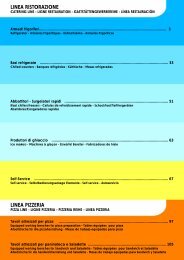- Page 1: VIVERE LA CUCINA CON PADERNO LIVING
- Page 6 and 7: SAMBONET PADERNO INDUSTRIE SPA
- Page 8: 8 10 18 24 30 34 38 46 48 50 52 54
- Page 11 and 12: THIS HIGHLY RESISTANT MATERIAL IS U
- Page 13 and 14: PENTOLAME INOX STAINLESS STEEL COOK
- Page 15 and 16: PENTOLAME INOX STAINLESS STEEL COOK
- Page 17 and 18: PENTOLAME INOX STAINLESS STEEL COOK
- Page 19 and 20: ALUMINIUM IS IDEAL FOR STIR-FRYING,
- Page 21 and 22: PENTOLE ALLUMINIO ALUMINIUM COOKWAR
- Page 23 and 24: PENTOLAME ALLUMINIO ALUMINIUM COOKW
- Page 25 and 26: COPPER IS CERTAINLY ONE OF THE BEST
- Page 27 and 28: PENTOLE RAME COPPER COOKWARE serie
- Page 29 and 30: PENTOLE RAME COPPER COOKWARE Crêpe
- Page 31: PORCELAIN IS PARTICULARLY APPROPRIA
- Page 35 and 36: THE BEST MATERIAL FOR FRYING IS IRO
- Page 37 and 38: FERRO IRON 36 Iron is ideal
- Page 40 and 41: PENTOLE SPECIALI SPECIAL ITEMS COOK
- Page 42 and 43: LIVING THE KITCHEN WITH PADERNO by
- Page 44 and 45: VIVERE LA CUCINA CON PADERNO by SAM
- Page 46: LIVING THE KITCHEN WITH PADERNO by
- Page 49 and 50: UTENSILI CUCINA KITCHEN UTENSILS CO
- Page 51 and 52: UTENSILI CUCINA KITCHEN UTENSILS CI
- Page 53 and 54: UTENSILI CUCINA KITCHEN UTENSILS DO
- Page 55 and 56: UTENSILI CUCINA KITCHEN UTENSILS ME
- Page 57 and 58: UTENSILI CUCINA KITCHEN UTENSILS H
- Page 59 and 60: UTENSILI CUCINA KITCHEN UTENSILS SP
- Page 61 and 62: UTENSILI CUCINA KITCHEN UTENSILS
- Page 63 and 64: UTENSILI CUCINA KITCHEN UTENSILS UT
- Page 65 and 66: UTENSILI CUCINA KITCHEN UTENSILS
- Page 67 and 68: UTENSILI CUCINA KITCHEN UTENSILS CU
- Page 69 and 70: UTENSILI CUCINA KITCHEN UTENSILS G
- Page 71 and 72: UTENSILI CUCINA KITCHEN UTENSILS
- Page 73 and 74: UTENSILI CUCINA KITCHEN UTENSILS BI
- Page 75 and 76: UTENSILI CUCINA KITCHEN UTENSILS TE
- Page 77 and 78: UTENSILI CUCINA KITCHEN UTENSILS
- Page 79: TEMPERATURE DI COTTURA CARNE MEAT B
- Page 82 and 83:
LIVING THE KITCHEN WITH PADERNO by
- Page 84 and 85:
VIVERE LA CUCINA CON PADERNO by SAM
- Page 86 and 87:
LIVING THE KITCHEN WITH PADERNO by
- Page 88 and 89:
VIVERE LA CUCINA CON PADERNO by SAM
- Page 90 and 91:
LIVING THE KITCHEN WITH PADERNO by
- Page 92 and 93:
VIVERE LA CUCINA CON PADERNO by SAM
- Page 94 and 95:
LIVING THE KITCHEN WITH PADERNO by
- Page 96:
VIVERE LA CUCINA CON PADERNO by SAM
- Page 99 and 100:
UTENSILI PIZZA PIZZA TOOLS 98
- Page 101 and 102:
UTENSILI PIZZA PIZZA TOOLS Pizza
- Page 103 and 104:
UTENSILI PIZZA PIZZA TOOLS SET up
- Page 105 and 106:
104
- Page 107 and 108:
106
- Page 109 and 110:
COLTELLERIA KNIVES COLTELLI FORGIAT
- Page 111 and 112:
COLTELLERIA KNIVES Steak knife
- Page 113 and 114:
COLTELLERIA KNIVES COLTELLI TRANCIA
- Page 115 and 116:
COLTELLERIA KNIVES Salmon knife,
- Page 117 and 118:
COLTELLERIA KNIVES COLTELLI SPECIAL
- Page 119 and 120:
COLTELLERIA KNIVES Parmesan knife
- Page 121 and 122:
COLTELLERIA KNIVES AFFILATOI SHARPE
- Page 123 and 124:
COLTELLERIA KNIVES TAGLIERI CUTTING
- Page 125 and 126:
COLTELLERIA KNIVES preparazione pre
- Page 127 and 128:
COLTELLERIA KNIVES FORBICI SCISSORS
- Page 129 and 130:
COLTELLERIA KNIVES
- Page 131 and 132:
COLTELLERIA KNIVES
- Page 133 and 134:
132
- Page 135 and 136:
134
- Page 137 and 138:
PASTICCERIA PASTRY TAGLIA PASTA CUT
- Page 139 and 140:
PASTICCERIA PASTRY BANDA STAGNATA T
- Page 141 and 142:
PASTICCERIA PASTRY BANDA STAGNATA T
- Page 143 and 144:
PASTICCERIA PASTRY TAGLIA BISCOTTI
- Page 145 and 146:
PASTICCERIA PASTRY BOCCHETTE DECORA
- Page 147 and 148:
PASTICCERIA PASTRY Set of 8 assor
- Page 149 and 150:
PASTICCERIA PASTRY UTENSILI DECORO,
- Page 151 and 152:
PASTICCERIA PASTRY PERFORATION Ø 3
- Page 153 and 154:
PASTICCERIA PASTRY UTENSILI PASTA P
- Page 155 and 156:
PASTICCERIA PASTRY Stencil for gr
- Page 157 and 158:
PASTICCERIA PASTRY Pastry brush
- Page 159 and 160:
PASTICCERIA PASTRY Cocoa dred
- Page 161 and 162:
PASTICCERIA PASTRY Silicone bakin
- Page 163 and 164:
PASTICCERIA PASTRY TORTIERE PASTRY
- Page 165 and 166:
PASTICCERIA PASTRY BANDA STAGNATA T
- Page 167 and 168:
PASTICCERIA PASTRY ANTI-ADERENTI NO
- Page 169 and 170:
PASTICCERIA PASTRY ANTI-ADERENTI NO
- Page 171 and 172:
PASTICCERIA PASTRY ANTI-ADERENTI NO
- Page 173 and 174:
PASTICCERIA PASTRY STAMPI SEMIFREDD
- Page 175 and 176:
PASTICCERIA PASTRY MILLEFOGLI BISQ
- Page 177 and 178:
PASTICCERIA PASTRY MASCHERINE PLAS
- Page 180 and 181:
CIOCCOLATO CHOCOLATE
- Page 182 and 183:
LIVING THE KITCHEN WITH PADERNO by
- Page 184 and 185:
VIVERE LA CUCINA CON PADERNO by SAM
- Page 186 and 187:
LIVING THE KITCHEN WITH PADERNO by
- Page 188 and 189:
VIVERE LA CUCINA CON PADERNO by SAM
- Page 190 and 191:
STAMPI SILICONE SILICON MOULDS
- Page 192 and 193:
LIVING THE KITCHEN WITH PADERNO by
- Page 194 and 195:
VIVERE LA CUCINA CON PADERNO by SAM
- Page 196 and 197:
LIVING THE KITCHEN WITH PADERNO by
- Page 198 and 199:
VIVERE LA CUCINA CON PADERNO by SAM
- Page 200 and 201:
LIVING THE KITCHEN WITH PADERNO by
- Page 202 and 203:
UTENSILI BAR BAR UTENSILS 202 204 2
- Page 204 and 205:
VIVERE LA CUCINA CON PADERNO by SAM
- Page 206 and 207:
LIVING THE KITCHEN WITH PADERNO by
- Page 208 and 209:
VIVERE LA CUCINA CON PADERNO by SAM
- Page 210 and 211:
LIVING THE KITCHEN WITH PADERNO by
- Page 212 and 213:
VIVERE LA CUCINA CON PADERNO by SAM
- Page 214 and 215:
LIVING THE KITCHEN WITH PADERNO by
- Page 216 and 217:
VIVERE LA CUCINA CON PADERNO by SAM
- Page 218 and 219:
LIVING THE KITCHEN WITH PADERNO by
- Page 220 and 221:
VIVERE LA CUCINA CON PADERNO by SAM
- Page 222 and 223:
LIVING THE KITCHEN WITH PADERNO by
- Page 224 and 225:
VIVERE LA CUCINA CON PADERNO by SAM
- Page 226 and 227:
LIVING THE KITCHEN WITH PADERNO by
- Page 228 and 229:
VIVERE LA CUCINA CON PADERNO by SAM
- Page 230 and 231:
LIVING THE KITCHEN WITH PADERNO by
- Page 232 and 233:
VIVERE LA CUCINA CON PADERNO by SAM
- Page 234 and 235:
LIVING THE KITCHEN WITH PADERNO by
- Page 236 and 237:
TAVOLA TABLE 236 238 243 244 248 24
- Page 238 and 239:
VIVERE LA CUCINA CON PADERNO by SAM
- Page 240 and 241:
LIVING THE KITCHEN WITH PADERNO by
- Page 242 and 243:
VIVERE LA CUCINA CON PADERNO by SAM
- Page 244 and 245:
LIVING THE KITCHEN WITH PADERNO by
- Page 246 and 247:
VIVERE LA CUCINA CON PADERNO by SAM
- Page 248 and 249:
LIVING THE KITCHEN WITH PADERNO by
- Page 250 and 251:
VIVERE LA CUCINA CON PADERNO by SAM
- Page 252 and 253:
LIVING THE KITCHEN WITH PADERNO by
- Page 254 and 255:
254 264 GRATTUGGIE GRATERS UTENSILI
- Page 256 and 257:
VIVERE LA CUCINA CON PADERNO by SAM
- Page 258 and 259:
LIVING THE KITCHEN WITH PADERNO by
- Page 260 and 261:
VIVERE LA CUCINA CON PADERNO by SAM
- Page 262 and 263:
LIVING THE KITCHEN WITH PADERNO by
- Page 264 and 265:
VIVERE LA CUCINA CON PADERNO by SAM
- Page 266 and 267:
LIVING THE KITCHEN WITH PADERNO by
- Page 268 and 269:
VIVERE LA CUCINA CON PADERNO by SAM
- Page 270 and 271:
LIVING THE KITCHEN WITH PADERNO by
- Page 272 and 273:
VIVERE LA CUCINA CON PADERNO by SAM
- Page 274 and 275:
LIVING THE KITCHEN WITH PADERNO by
- Page 276 and 277:
VIVERE LA CUCINA CON PADERNO by SAM
- Page 278 and 279:
MISURE e CAPACITÀ MEASURE & CAPACI
- Page 280 and 281:
VIVERE LA CUCINA CON PADERNO by SAM
- Page 282 and 283:
LIVING THE KITCHEN WITH PADERNO by
- Page 284 and 285:
INDICE ALFABETICO ALPHABETICAL INDE
- Page 286 and 287:
285
- Page 288 and 289:
LIVING THE KITCHEN WITH PADERNO by
- Page 290 and 291:
289 INDICE ALFABETICO ALPHABETICAL
- Page 292 and 293:
LIVING THE KITCHEN WITH PADERNO by
- Page 294 and 295:
INDICE PER CODICE CODE INDEX 293
- Page 296 and 297:
295 INDICE PER CODICE CODE INDEX VI
- Page 298 and 299:
297 INDICE PER CODICE CODE INDEX
- Page 300 and 301:
PAROLA ALLO CHEF CHEF’s SPEAKING
- Page 302 and 303:
VIVERE LA CUCINA CON PADERNO by SAM
- Page 304 and 305:
LE MIE RICETTE MY RECIPE BOOK 303
- Page 306 and 307:
TEMPO TIME LE MIE RICETTE MY RECIPE
- Page 308 and 309:
TEMPO TIME LE MIE RICETTE MY RECIPE
- Page 310 and 311:
TEMPO TIME LE MIE RICETTE MY RECIPE
- Page 312 and 313:
TEMPO TIME LE MIE RICETTE MY RECIPE





